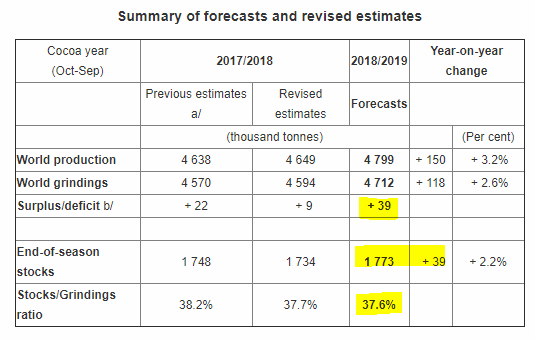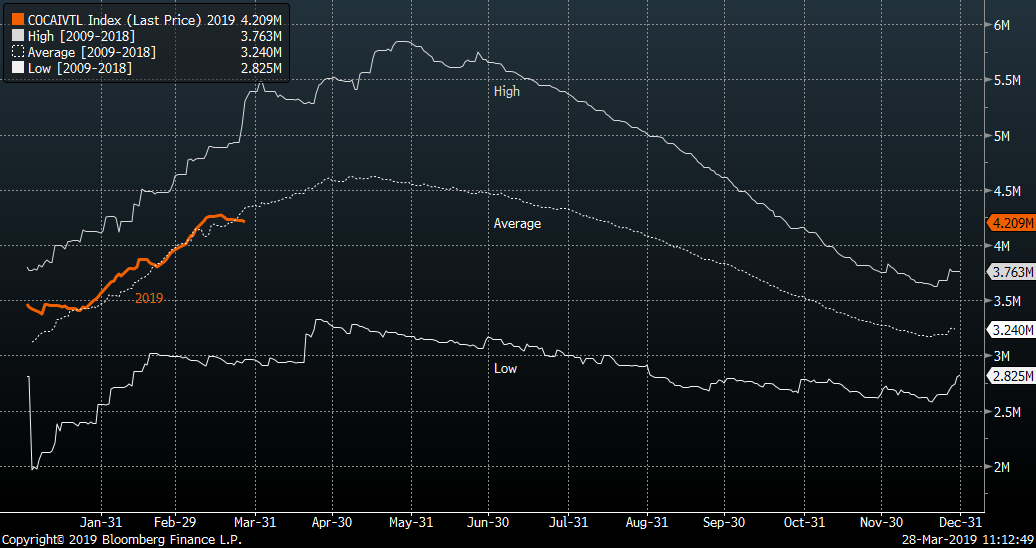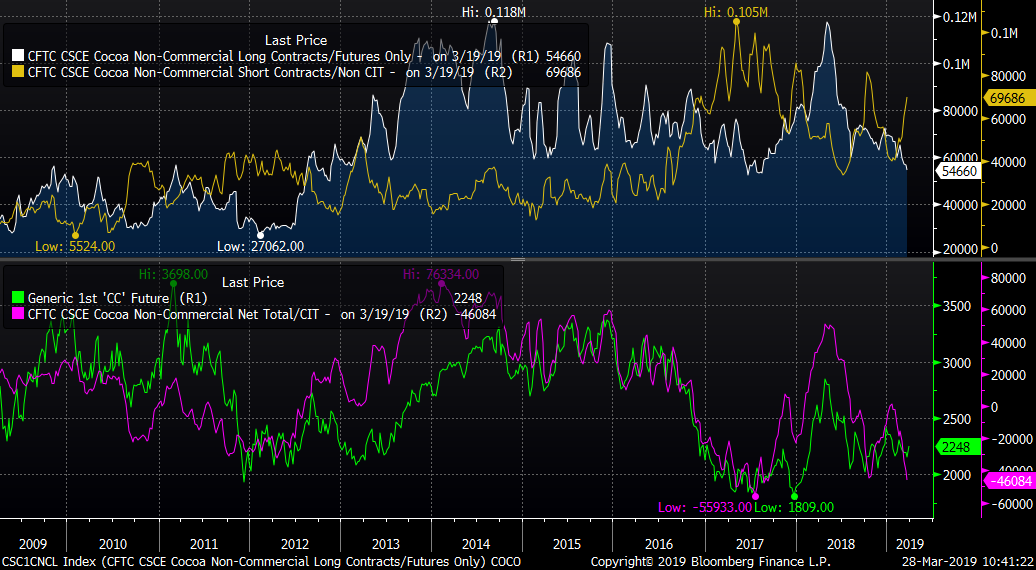Summary:
- Cocoa prices rebound due to a possibility to create an African cartel of producers
- Production outlook remains quite buoyant
- Weather conditions could limit the ongoing prices rise
- Speculative positioning suggests possibly higher prices ahead
Will Africa create an OPEC-like cartel?
Start investing today or test a free demo
Create account Try a demo Download mobile app Download mobile appWestern countries as well as chocolate producers are among the biggest beneficiaries of the cocoa industry. It needs to be underlined that cocoa producers get solely a 5-7% share of the entire industry being worth on average over $100 billion each year. Therefore, nobody should be particularly surprised that African countries want a change strengthening their position in the production process. Recently we have been offered some signals that they are trying to form a OPEC-like cartel so as to get a possibility to keep prices under control. Below we present some key points.
The state of play:
-
Ivory Coast and Ghana account for roughly 60% of the whole cocoa output in the world
-
African countries (mainly western) account for ca. 75% of the global cocoa output
-
In Ghana commodity is purchased by the regulator which then resale its stocks directly to buyers (it bypasses exchanges)
-
In Ivory Coast there are cocoa auctions with a minimum price set for farmers
-
Both countries are major competitors for themselves
-
As much as 80% of cocoa is sold throughout futures contracts even before the season kicks off, such activity reduces a chance to see higher prices
-
Traders well know that African countries are heavily dependent on cocoa exports, thus they can want until these countries are forced to sell its crops at lower prices
Changes ahead:
-
Ghana and Ivory Coast could set prices together (some indications point to $2255/2650 per ton
-
Ivory Coast wants to start operating under the new system from October
-
Ivory Coast has sold 500k tones out of the 1400k tones planned for the next season
-
There is a vision to build large warehouses for cocoa storage
-
Ivory Coast resigns from its plan to boost cocoa yield after the past record seasons
-
Stricter regulations aimed at preventing cocoa smuggling between the two countries
These proposals sound quite well from the cocoa prices’ point of view given the fact that a lion’s share of the market is under control of the two mentioned countries. Moreover, there has been an increase in cocoa processing activity in Africa in recent years, this could boost producers’ margins. In theory, one may arrive at a conclusion that cocoa prices are in a good position to experience some rises. However, the ongoing prices rise could be speculative.
Fundamental factors
The fundamental outlook does not look bad for the cocoa market. The data for November signalled a production surplus of 22k tons, albeit the data was revised down to 9k tons thereafter. The next year’s projection points to a further output increase which is expected to translate into higher stock levels. On the other hand, the stocks-to-consumption ratio is forecast to tick down which could be supportive of cocoa prices in the medium to longer-term. It is also worth mentioning that a surplus has become a new normality in recent years. However, in the years when a surplus was decreasing we got some price rises.
 The level of cocoa inventories is quite high but the longer-term outlook does not look bad. The stocks-to-consumption ratio hovers around its historical lows giving some hope for bulls. Source: Bloomberg
The level of cocoa inventories is quite high but the longer-term outlook does not look bad. The stocks-to-consumption ratio hovers around its historical lows giving some hope for bulls. Source: Bloomberg
 The next year’s projections point to a surplus increase but this rise is going to be negligible. Source: ICCO
The next year’s projections point to a surplus increase but this rise is going to be negligible. Source: ICCO
Stocks in ports may be pivotal
Among key features describing the cocoa market is lack of information. Even major producers are reluctant to disclose any data instead they want to get an advantage over competitors. However, some difficulties is cocoa deliveries could be noticed in inventories in ports. If these stocks decline, cocoa prices could benefit. Nevertheless cooperation between producers remains a key element in preparing a common strategy.
 Cocoa stocks in ports follow their 10-year average. Source: Bloomberg
Cocoa stocks in ports follow their 10-year average. Source: Bloomberg
Positioning gives a signal
 The positioning data offers a strong buying signal. However, even as longs have decreased of late, shorts have increased at the same time. The cocoa market is one of the most speculative in its nature where traders want to force major producers to lower prices. Having this in mind we expect that shorts may yet increase in the short-term which in turn could push prices a bit lower. A fall in the net position toward -60k could produce a strong buying signal. Source: Bloomberg
The positioning data offers a strong buying signal. However, even as longs have decreased of late, shorts have increased at the same time. The cocoa market is one of the most speculative in its nature where traders want to force major producers to lower prices. Having this in mind we expect that shorts may yet increase in the short-term which in turn could push prices a bit lower. A fall in the net position toward -60k could produce a strong buying signal. Source: Bloomberg
Technical outlook
Over the course of the past 10 years cocoa prices did not show any seasonal patterns. However, the current level of prices is below both 5y and 10y averages. Over the longer-term one may notice that cocoa prices tend worse perform between March and May. Then a consolidation until mid-June is often present followed by sharp rises during the next one and a half months. Technically bulls have respected the medium-term trend line. However, cocoa prices are hovering within the bearish channel. Note also that the 200DMA has tended to be a strong resistance for prices. Thus, we look for a short-term pullback toward 2100-2150 from where one may expect a rebound of the net position declines.
 Cocoa prices may yet fall a bit before rebounding. Source: xStation5
Cocoa prices may yet fall a bit before rebounding. Source: xStation5
This content has been created by XTB S.A. This service is provided by XTB S.A., with its registered office in Warsaw, at Prosta 67, 00-838 Warsaw, Poland, entered in the register of entrepreneurs of the National Court Register (Krajowy Rejestr Sądowy) conducted by District Court for the Capital City of Warsaw, XII Commercial Division of the National Court Register under KRS number 0000217580, REGON number 015803782 and Tax Identification Number (NIP) 527-24-43-955, with the fully paid up share capital in the amount of PLN 5.869.181,75. XTB S.A. conducts brokerage activities on the basis of the license granted by Polish Securities and Exchange Commission on 8th November 2005 No. DDM-M-4021-57-1/2005 and is supervised by Polish Supervision Authority.

